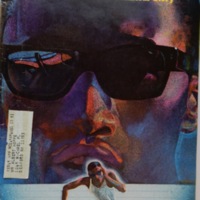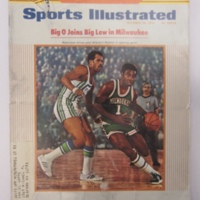Browse Exhibits (2 total)
Sports Illustrated "The Black Athlete"

Sports Illustrated from July 1, 1968 included feature content about Black athletes, called "The Black Athlete: A Shameful Story." The July 1 issue was the first installment of a five-part series by Jack Olsen. Part 1 is titled "The Cruel Deception" and investigates the notion that sports was the most progressive national arena for positive race relations and opportunity for black youth in mid-twentieth century. Olsen uncovers the many fallacies of this concept by exploring the realm of collegiate athletics. He delves into the social and academic struggles that arise as black youth matriculate into predominantly white universities to play sports, discussing everything from money management, dating, and coursework. The feature draws on the voices of black athletes themselves as they discuss their grievances, their athletic performance, their public activism, and their experience of race in sports. Many of the athletes interviewed were nationally recognized, some professional. Olsen's other interviews ran the gamut from sociologists, to black community leaders, to white athletic directors and coaches. Sports Illustrated deemed this long form essay one of its most important features, and an uncharacteristic dive into the tense racial cauldron of the United States. However, the piece was notably geared only toward white readers. Olsen's language and positioning throughout the piece are telling of audience demographic; he often implies the separation of his readers--and himself--from black communities and the issues they face, in sports and otherwise. Olsen also often identifies as white and acknowledges white cultural ideology, even as he challenges it. The ads embedded in the pages of the story are even more striking. The ads feature only white people, and these figures are usually engaging in traditionally 'white' cultural practices like deep sea fishing and skiing. The feature archived in this collection reveal the ways in which Sports Illustrated used athletics as a context in which to discuss racial tension and oppression with a white readership.
Black Athletes "on the Ropes" with Masculinity

With its first issue published in 1954, Sports Illustrated has gone through decades of transformation. When it first began, its creator—Henry Luce— hoped to expand the types of publications distributed by Time Inc. After Andre Daguerre took over as managing editor in 1960, the popularity of SI grew. [1] They covered all sporting events from basketball and tennis, to skiing and football. With their stories and photos, they allowed their readers to get a glimpse into the lives of American athletic heroes. SI issues went beyond just the plays of the game, game statistics and quality of the players. The articles delivered first-hand accounts of what motivated and frightened the athletes. The articles, whether they meant to or not, served to humanize the athletes and helped sports audiences identify with them.
Three specific articles— “A Rueful Dream Come True,” “Still Too Tender to Be a Tiger” and “He Moves Like Silk, Hits Like a Ton”— were all published towards the end of the 1960s into the early 70s and highlight the stories of two boxers: Muhammad Ali and Floyd Patterson. When analyzed together, not only do the articles detail the social and political transformations in the boxing world, they also comment on the boxers’ masculinity and what was required of athletes to be recognized as serious, All-American, professionals. The items in this collection exhibit how different language is employed by the authors when describing the careers of Ali and Patterson. As a result, Ali is framed as true athlete and hero, while Patterson is framed as a weak, emotional person not fit to fight in the ring.
—————
1. "Sports Illustrated". Encyclopædia Britannica. Encyclopædia Britannica Online.
Encyclopædia Britannica Inc., 2016. Web. 02 Nov. 2016
<https://www.britannica.com/topic/Sports-Illustrated>.